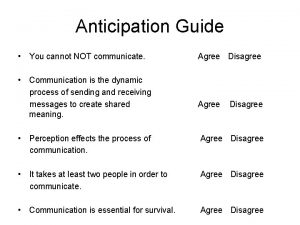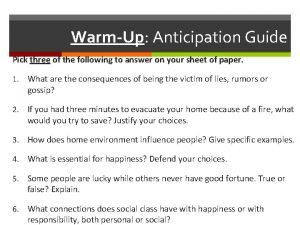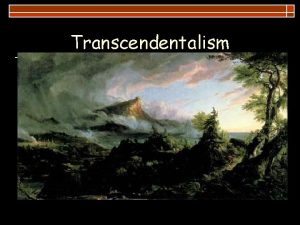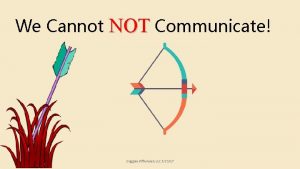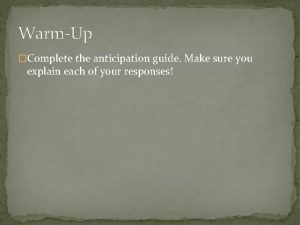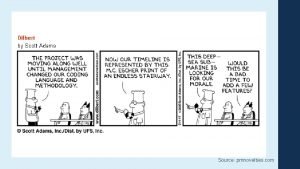Anticipation Guide You cannot NOT communicate Communication is












- Slides: 12

Anticipation Guide • You cannot NOT communicate. • Communication is the dynamic process of sending and receiving messages to create shared meaning. Agree Disagree • Perception effects the process of communication. Agree Disagree • It takes at least two people in order to communicate. Agree Disagree • Communication is essential for survival. Agree Disagree

What is communication? ØWhy do we communicate? ØHow many people does it take to communicate? ØWhat does “You Cannot NOT Communicate” mean to you?

Defining Communication • Communication is a dynamic process. • Book definition: The process of sending and receiving messages.

The Process of Communication • One Way Communication vs. Two Way – Volunteer for class activity

How we communicate • One Way Communication: Ø Self-Action Ø Focused on getting the message to the receiver. NO FEEDBACK! Ø Treats communication as a manipulation of others. Very MESSAGE centered. EX: Radio stations, billboards, etc. • Two Way Communication: Ø Interaction Ø Recognizes the role of the receiver as a communicator. Ø FEEDBACK (cares if the message was received=shared meaning) Ø Promotes mutual understanding and respect EX: Resolving conflicts)

How we communicate • Communication Goal=Shared Meaning – Messages can be complicated by perceptions (field of experience)of others. • Denotative: commonly known or dictionary meanings. • Connotative: based on personal experience and can be emotional or evaluative.


The Five Types of Communication • • • Intrapersonal: Communicating with yourself. Ex: planning what to say before you say it or thinking about how to solve a problem. Interpersonal: Interaction between two people. The most common type of communication. Ex: with family members, friends, coworkers, and students. Small Group: Every member can participate actively with other members. Usually three or more people. The difference is that members can take sides and leadership roles emerge. Ex: family, athletic team, or group of students working on a project. Public Speaking: This occurs when a group becomes too large for all members to contribute. Speaking is planned and there is little feedback. Ex: public speech or performance. Mass Communication: Messages transmitted to large audiences via broadcast and print media. Ex: newspapers, magazines, television, radio, Internet.

Schramm’s Model of Communication

SENDER One who transmits a message ENCODE Putting thoughts into a verbal or nonverbal signal RECEIVER One who decodes a message DECODE To interpret a message INTERFERENCE/BARRIER Obstacles that may block the transmission of a message (Internal/External) Psychological or Physiological MESSAGE/SIGNAL The sender’s verbal/nonverbal words and other symbols CHANNEL The means through which the signal travels FEEDBACK Reaction of the receiver to the message FIELD OF EXPERIENCE Area of knowledge, background, and experience DESIRE TO COMMUNICATE Your need to express an idea to another person

Schramm’s Model of Communication Field of Exp. Sender Desire to Comm Encode Message Channel Interference/Barrier Feedback Decode Receiver

Model of Photosynthesis
 You cannot not communicate
You cannot not communicate If you can't measure it you cannot improve it
If you can't measure it you cannot improve it If you can't measure it you cannot improve it
If you can't measure it you cannot improve it If you can't measure it you can't manage it
If you can't measure it you can't manage it Copyright
Copyright Responsive anticipation and creative anticipation
Responsive anticipation and creative anticipation This supernatural soliciting cannot be ill cannot be good
This supernatural soliciting cannot be ill cannot be good American born chinese book trailer
American born chinese book trailer The crucible anticipation guide answer key
The crucible anticipation guide answer key Dystopian anticipation guide
Dystopian anticipation guide Beowulf anticipation guide answer key
Beowulf anticipation guide answer key Transcendentalism anticipation guide
Transcendentalism anticipation guide Tkam anticipation guide
Tkam anticipation guide
